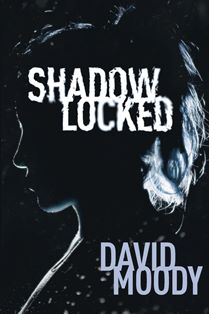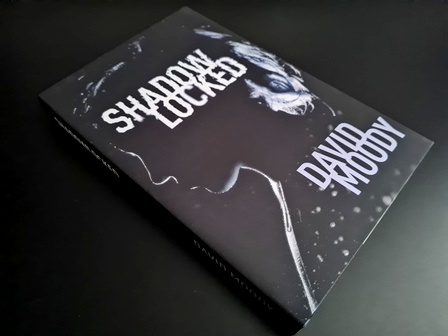
First published back in May of 2024, David Moddy’s novel ‘Shadowlocked’ took a brave step away from the author’s home ground of post-apocalyptic fiction, instead exploring the complexities of human perception, and the reach which emotional control can destroy a life so completely.
Lucy was driving her husband home after a big work night out when tragedy struck. It was late at night and rain was pouring down, making driving conditions treacherous. Lucy hadn’t had a drop to drink, but Adam was the worse for booze.
They were taking a narrow bridge when Lucy had seemingly lost control of the vehicle, smashing through the sides and plummeting into the swollen river below. Within seconds, bitterly cold river water was flooding in through Adam’s open window.
In the chaotic madness from the onrushing water, Lucy manages to get Adam’s seatbelt unlocked. He claws himself out of the window, but before he can reach back for Lucy, he’s swept away by the ferocity of the river’s current.
Waking up in a hospital bed, Adam’s recollection of what happened is patchy at best. But slowly it all starts returning. The party where they’d had a run in with an aggressive lout. The journey home in the torrential rain. The BMW which had been following them, attempting to intimidate them. And then how the driver had intentionally read-ended them at high speed.
Adam’s life has come crashing down around him. He knows there’s someone out there who was intrinsically involved in his wife’s death. Despite what the police say, he knows it wasn’t a straightforward accident. And he’s going to find whoever it was that caused this.
But Adam’s struggling with what’s happened. He’s starting to see for form of Lucy, here there and everywhere, silently watching him. A ghost of his dead wife, seemingly unable to communicate. Unable to reach out. In a halfway state, stuck between real and imaginary, trapped between light and shade. Shadowlocked…
David Moody might be best known for his contributions to the post-apocalyptic subgenre, however, those who’ve followed his work will undoubtedly see something a bit deeper that connects his stories. The human element. He takes otherwise ordinary individuals and throws them into an extraordinary situation. Those characters then become the principal focus of the story rather than the extraordinary setting their suddenly within.
So here, we have a husband and wife, both in their early thirties. Tragedy hits and the wife is killed. Of course this catapults the husband’s life into absolute turmoil. He feels like he’s lost everything. With the story told in first-person through the eyes of this broken man, Moody captures the impact of this gut-wrenching, absolute loss, so vividly. The way such loss sinks through your soul and drags you down day after day. Inescapable and absolute.
Then the first glimpses of Lucy’s ghost set us down a particular track. They start us thinking where we might be being led. In fact, for the entirety of the tale, Moody very purposefully leaves the question open regarding whether the ghost of Lucy is real or just in Adam’s head. But to be honest, as odd as this might sound, the answer to that isn’t important. This is again about the characters and their story.
For this particular reader and reviewer, where the beating heart of the tale resides is with the gradual unveiling of the truth hidden behind closed doors. And those closed doors can sometimes be internal ones. How you might see yourself versus reality. You see, the story is told from the perspective of Adam. The heartbroken husband who we instantly side with. In those early pages our heart goes out to him and from that acorn we start to forge bonds with the character.
However, gradually, ever-so-slowly, so that we might not notice it at first, we start to pull away from the character, as more and more of who he is comes to light. But we see this all through Adams’ eyes. A one-sided perspective which we gradually learn is blurred and clouded. A distorted reality.
What transpires is a novel drenched in bitter raw emotion. There’s a sense of unveiling of the truth. From this, your own self-reflection becomes a side product of reading the book. We wonder if we too sometimes have a one-sided perception of ourselves, which is in reality far from the truth. But we just don’t see it that way. Hopefully, nothing like Adam though. Now that guys a fucking bastard.
Personally, I found one of the strongest elements in the novel to be delivery of this unique perspective that we’re provided. We’re fed the story from Adam’s perspective, a single-sided perception, which we find isn’t necessarily reality. The whole concept reminded me of the ideas around perspective which were cleverly explored within the entire ‘Hater’ series, and came to the foreground so effectively with the changes with Danny McCoyne in ‘Dog Blood’ (2010). It’s that whole ending-to-‘I Am Legend’ (1954) perspective thing. Only here what we’re fed is Adam’s warped, subconsciously twisted version. His inner perception and self-delusion.
Empathy, or more precisely the distinct lack of any form of empathy, is also a key part of the book. As a reader, we feel like voyeurs, observing the lives of this husband-and-wife relationship in reflection, but always from Adam’s quarter. We see how Adam perceives himself, but gradually, piece by piece, we start to see the cracks forming in this perception. The lack of actual thought for the other person’s perspective. The lack of actually feeling for them. The lack of understanding... emphasising.
Control is another key element. Emotional control that’s so cold, so misguided from Adam’s perception of himself, that it lands on the reader like the weight of a car at the bottom of a swollen river. It’s this element that consumes the latter third of the book. And to be honest, the truth that gradually rises to the surface, feels suffocating. Like a stranglehold around your throat.
Ultimately, the novel feels like an autopsy. The gradual cutting away of layers to eventually reveal the internally bruised and broken, cold, dead truth. And we view this from behind an observation window, whilst the ‘pathologists voice’ describes a very different cause of death than the one we’re seeing with our own eyes.
This is a novel that’s full of heartache. A tale wrapped up in a cold sheet of tragedy and loss, which penetrates further into your own skin than you’d expect it to. It’s also one which shows how easy it is to become tainted by a one-sided perception. You’ll feel let down, frustrated, deceived and then angered when the veil is eventually lifted.
Moody has achieved this through a tight relationship between the characters and the reader. The cunning use of first-person perspective is delivered with genius effect when combined with this gradual unravelling of the internal lies.
This novel might be a step away from the author’s usual home ground, but the heart and soul of Moody’s writing style still echoes through. It’s a story that connects with the reader, then purposefully, gradually, whittles away at those bonds. A powerful and purposefully emotive offering from an author who knows more about what resides under the flesh and blood of our physical bodies than he possibly, probably realises…or dares to admit.
The novel runs for a total of 273 pages.
Was She Ever There? – 9 Pages
[Limited Edition Hardback – Bonus Material]
The limited edition hardback version ends with an in-depth essay from Moody which takes us through the inspiration and writing of the story. In this we learn that the novel has been the product of many years of writing, reworking and refining the ideas within it, that it came from a vivid singular sequence in a nightmare, and gradually evolved over numerous drafts. How in its construction we have three disparate ideas, coming together to form the readers’ journey through the story. Moody talks about the whole “is she a ghost, or isn’t she?” aspect, as well as the idea of invisibility and indeed ghosts. As with the afterwords and essays Moody’s provided within previous bonus material, this is all written in a very open and honest voice. An unaltered, unpolished self-reflection giving the reader a wonderfully in-depth insight into the book, its inspiration and ideas, and the author himself.

© DLS Reviews










